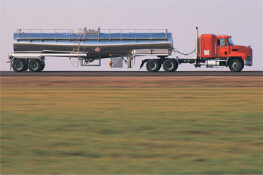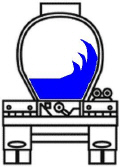True/False
Indicate whether the
statement is true or false.
|
|
|
1.
|
A tank truck with baffles will handle on the road the same as a tank truck
without baffles.
|
|
|
2.
|
Forward and backward surge is strongest in a smooth bore tank.
|
|
|
3.
|
The term “outage” refers to the air space in a tank that allows the
liquid cargo to expand.
|
|
|
4.
|
A Class A or Class B driver of a vehicle that hauls liquid or liquid gas in a
permanently mounted cargo tank rated at 119 gallons or more (or a portable tank rated at 1,000
gallons or more) is required to have a tank endorsement on their CDL. 
|
|
|
5.
|
Wet roads can double the stopping distance of a truck.
|
|
|
6.
|
Empty tanker trucks require greater stopping distance than full ones.
|
Multiple Choice
Identify the
choice that best completes the statement or answers the question.
|
|
|
7.
|
A high center of gravity means that a tanker is top heavy and can easily
_____________.
a. | Load. | b. | Stop. | c. | Break. | d. | Roll over. |
|
|
|
8.
|
When you load and unload the small tank compartments of a large cargo tank that
has bulkheads, you should check the:
a. | Water content. | b. | Distribution of weight. | c. | Air-to-fuel
ratio. | d. | All of the above. |
|
|
|
9.
|
Which of the following is true about a truck that has a cargo tank with
baffles?  a. | The truck will seem heavier than it really is on the road. | b. | The truck will seem
lighter than it really is on the road. | c. | The truck will have less front to back surge
than a tank without bulkheads or baffles. | d. | All the weight of the load will be at the rear
of the vehicle. |
|
|
|
10.
|
You should be very careful when driving a smooth bore tanker, especially when
you are:
a. | Coupling or uncoupling. | b. | Going uphill. | c. | Driving against the
wind. | d. | Starting or stopping. |
|
|
|
11.
|
What does this picture show you?  a. | Side-to-side surge. | b. | Front-to-back surge. | c. | Top-to-bottom
surge. | d. | The effect of a baffled tank. |
|
|
|
12.
|
What does a forward liquid surge do to the handling of a tank truck when
stopping quickly?
a. | It makes the truck stop faster. | b. | It has no effect on
stopping. | c. | It can force the truck in the direction of the surging liquid
wave. | d. | It creates better traction. |
|
|
|
13.
|
Which of the following are good safe driving rules for driving on curves with a
tank truck?
a. | Slow down before curves. | b. | accelerate slightly through the
curve. | c. | Reduce speed below the posted speed limit. | d. | All of the
above. |
|
|
|
14.
|
You are driving a tanker on a clear night. You must dim your headlights
from high to low. You should adjust your speed so that you can stop within
_______________.
a. | The distance that you can see ahead with your headlights. | b. | The distance you
will travel in 12-15 seconds. | c. | The length of your vehicle. | d. | 100
feet. |
|
|
|
15.
|
When should tanker drivers who have lost their brakes use a truck escape
ramp?
a. | Never. | b. | Always. | c. | Only when the tank
is empty. | d. | Only when driving a smooth bore tanker. |
|